Oh! Nuts ◊ Bulk Nuts & Seeds ◊ Bulk Almonds
Bulk Almonds
Browse our complete selection of Bulk Almonds
 | |||
 | |||
 | |||
 | |||
 | |||
 | |||
 | |||
 | |||
ALMONDS
A complete guide
Where did almonds originate?
Almonds have always grown in warm, dry climates such as western Asia, gradually
spreading westward to the Mediterranean basin. In 716 A.D., almonds had been
introduced to Northern Europe, as we learn from a charter given to a monastery
in Normandy by the King of France. In 812, Charlemagne commanded that almond
trees be planted on the royal grounds.
By the 1300?s, almonds were already growing on some Greek islands. In
1411, tithes were levied on almonds, honey and sesame seed in Cyprus.
What else do we know about the almonds history?
There are numerous biblical references to the almond. Almonds, as well as filberts,
chestnuts and walnuts, have also been identified in the remains of carbonized
material from the eruption of Mount Vesuvius in 79 A.D.
Almonds were very popular in England, where they had been introduced by Romans
at a very early date. Thus, we find in a royal cookbook, dated in the l300?s,
at the court of King Richard III, ingredients such as ?Creme of Almand,
Grewel of Almand, and Cawdel of Almand Mylke?. Shakespeare often made
reference to almonds, which were considered a mouthwatering delicacy. (See
Troilus and Cressida, Act V, Scene 2, where Thersites states, ?The parrot
will not do more for an Almond.?) There is also a record of the inventory
of the queen of France?s kitchen in 1372, containing only twenty pounds
of sugar, but five hundred pounds of almonds!
In the Middle Ages, many magicians chose an almond rod for performing their
hocus-pocus. Forked almond sticks were used as divining rods for dowsing, for
locating buried treasure and even for finding underground water.
As a symbol of good luck, almonds have been unsurpassed. Candied almond nuts
are customarily distributed at Greek weddings to symbolize long life and happiness.
In 1597, John Gerard, who published a famous herbal, wrote that ?five
or six (almonds) being taken fasting do keepe a man from being drunke.? Perhaps
this sage piece of advice was the basis of today?s cocktail nut.
During the four centuries following the death of Mohammed in 632, his empire
spread out and flourished from Spain in the west to the Chinese border in the
east, spanning some 7,000 miles. When the Arabs conquered Persia they acquired
a taste for almonds. In Baghdad, a popular dish was harisa, a stew with meat
and vegetables, served with a sauce thickened with powdered almonds.
The period of the Crusaders, from the eleventh through thirteenth centuries,
reopened the trade routes to the East. Thus, the Crusaders brought back to
western Europe new methods of cooking, as well as exotic spices. Europeans
acquired a taste for Arab cuisine, including creamy almond sauces, as well
as almond-based confections, such as nougat and marzipan, which are made with
ground almonds stirred into a sugar paste.
Shortly thereafter, the cultivation of almonds spread from Greece and Italy
to North Africa, Spain, Portugal and France. From the middle ages until the
1700?s, nuts became a major source of substitute ?milk?.
This was produced by blanching almonds and walnuts, that is, removing the thin
skin by means of steam or hot water, then grinding the nuts into a fine powder,
which was soaked in water to give it a ?milky? consistency.
What are some non-food uses for the almond?
Today almond oil is a vital ingredient in cosmetics, such as theatrical makeup.
Already in the 1600?s, a French woman of fashion concocted an almond
based cold-cream which was credited for keeping her face wrinkle-free until
the age of seventy. The Ninon de Lenclos Ointment contained 4 oz. almond
oil, 3 oz. hog?s lard and 1 oz. of spermaceti, which is a yellowish,
waxy solid obtained from sperm whale oil.
When were almonds planted in America?
Towards the end of the 1700?s, edible almonds were planted in the Spanish
missions located between San Diego and Santa Barbara, California. However,
the damp and foggy climate was inappropriate for growing almonds. Attempts
to cultivate almonds were undertaken in New England and the Middle Atlantic
states in the early 1800?s. Here it was the spring frosts that damaged
the delicate almond blossoms, which appear early in the season. The almond
apparently required a mild, Mediterranean-type of climate in order to flourish.
Where are almonds grown in the United States?
In the middle of the nineteenth century almonds were brought to California
from nursery stock in New York. Several areas in north-central California proved
especially suitable for commercial almond production. Today 99% of all almonds
grown in the United States come from one long stretch of land in California,
covering four hundred miles, from Bakersfield to Red Bluff. There are over
seven thousand individual growers, cultivating approximately 420,000 acres
of land planted with almond trees. In terms of acreage, dollar value and world
distribution, almonds are California?s most important tree crop. Whereas
years ago the United States imported all of its almonds from Europe, today
California has become the supplier of not only the entire domestic market,
but of over half of the market of the rest of the world. The average yield
of almonds per acre in California is about 1,800 pounds of in-shell nuts.
Where else in the world do almonds grow today?
Spain devotes over three times the acreage of California to almonds, yet its
production is less than one half that of California. This is because in Spain,
most almonds grow on thousands of small farms, located near the Mediterranean
Sea. The soil is generally poor and dry, and Spanish farmers rely on natural
rainfall, whereas in California it is rare to find an unirrigated almond
orchard. The end product is a nut that has a hard, thick shell, and a low
edible-nut-to-shell ratio. The trees in Spain generally produce less almonds
than those in California. Almond production in Italy and Portugal is similar
to that of Spain.
Almonds are the most important and versatile of all tree nuts, enjoying the
largest share of the world tree nut trade. In 1982, total world production
of almonds was estimated at about 573 million pounds. Of this, the United States
(California) produced about 331 million pounds, Spain 137 million pounds, and
Italy 40 million pounds. Other countries that produce almonds are Afghanistan,
Algeria, China, Cyprus, France, Greece, Iran, Morocco, Portugal, Turkey, Tunisia
and Yugoslavia.
What is the almond tree like?
The almond tree is a graceful, medium-sized tree, that closely resembles the
peach, plum and apricot. The almond fruit is similar to a peach, and consists
of an edible seed or kernel, a shell and an outer hull. At maturity the hull
splits open. When dry, it is easily separated from the shell. The main difference
between a peach and an almond is that the sweet, luscious outer flesh of
the peach is eaten while its pit containing the seed is thrown away, whereas
with an almond it is the pit that is desirable for food while its thin, fibrous
outer flesh is discarded.
An almond tree can grow to a height of twenty to thirty feet. Its wood is harder
than that of the peach. Also an almond tree lives longer than a peach tree.
The borders of its leaves are finely toothed.
Are there different types of almonds?
There are two basic types of almonds: sweet and bitter, with some intermediate
types. The sweet almond is cultivated for its edible nuts. Bitter almonds
are grown for their bitter almond oil, which is used both as a flavoring
as well as an ingredient in cosmetics. Whereas sweet almonds are nourishing
and healthful, bitter almonds may cause cyanide poisoning if ingested. Fortunately,
their bitter taste prevents a lethal dose to be consumed at one sitting.
Besides the cultivated almond, there are more than thirty other wild or minor
species.
Of all European almonds, the Jordan almond is one of the best-known varieties.
Its name is probable a corruption of the French jardin, which means ?garden?.
This variety has not been grown successfully in California. However, other
superior almond cultivars (clones or varieties) have been developed in California.
The most important of these is the Nonpareil, which accounts for over 50% of
the total California production. Its shells are paper thin and soft. The next
most important cultivar in California is the Mission. This one has a harder
shell and a slightly bitter flavor.
Other major California almond varieties are: Merced, Carmel, Ne Plus Ultra,
Thompson and Peerless. These seven cultivars account for roughly 90% of the
almonds grown in California.
How are almonds cultivated?
Since flowers of most almond varieties are genetically self-incompatible, it
is necessary to interplant two or more cross-compatible cultivars that bloom
at about the same time, in order to achieve successful pollination and fertilization.
The sticky, heavy pollen is transferred principally by bees, which are brought
into the orchards in February, when the almond trees begin to bloom. The
honey bee industry is essential for almond production.
Almond trees grown from seed do not reproduce true to variety. Therefore, in
California, almonds are propagated by various techniques, such as grafting
material of the most desirable varieties onto rugged root-stock seedlings,
or using almond seedlings from special sources.
When planted in the field, almond trees are usually spaced 24 to 30 feet apart.
Branches are trained and pruned, so that the tree is shaped for efficient bearing,
to avoid crowding and competition, and to permit mechanical equipment to pass
under the branches.
It takes three to four years for an almond tree to produce fruit, and then
another three to four years for it to reach the stage of heavy production.
Fertilizing almond trees with nitrogen is extremely helpful.
What are some of the problems encountered in the cultivation of almonds?
There are several diseases which can afflict the almond, adversely affecting
the yield and quality of the crop. With time, they can even weaken and kill
the trees. Some of these are:
?
Brown rot?, which attacks the blossoms, spreading into the spurs and
shoots;
?
Shothole?, a fungus which attacks flower buds, blossoms, young fruits
and leaves;
?
Blast? or bacterial canker, which kills both buds and blossoms;
?
Crown rot?, ?crown gall? and ?Poria wood rot?.
Sometimes almonds suffer from a genetic disorder which causes ?bud failure?.
Recently, a serious leaf disorder has developed. It is known as almond leaf
scorch or ?golden death?, and is similar to Pierce?s disease
in grapes. It is spread by several species of leaf hoppers.
California almond growers must constantly be on the alert for diseases and
pests. Many of the aforementioned diseases can be controlled by fungicides.
A disease known as ?noninfectious bud failure? (or ?crazy
top?) can be controlled by specific methods, and pests such as navel
orange worms, peach twig borers, ?San José scale? and various
other mites can be treated with selected insecticides.
How are almonds processed?
As the almond fruit approaches maturity, its hull begins to split open. Usually
the nuts are harvested mechanically: a mechanical knocker shakes the trees,
causing the nuts to fall to the ground. Mechanical sweepers place the nuts
in windrows, after which they are gathered by pick-up machines and transported
to hullers to remove the leathery outer cover, or hull. Hulls are used as
feed for livestock.
The nuts are then dried, so that their moisture contents is reduced to less
than 8%. For long storage periods, the nuts should be fumigated and kept at
temperatures below 40°F, or severe worm infestation may occur.
The almonds are then delivered to a packing company to be shelled, processed
and packaged. At the processing plant, the nuts pass through cracking machines,
where the kernels are separated from the shells. The shells are blown away
and separated, to be used in the manufacture of charcoal briquets, or as roughage
for cattle feed. At the California Almond Growers main plant in Sacramento,
all shells are now conveyed directly from the shelling machines to an adjacent
co-generation plant where they are burned to produce electricity. Some of this
energy powers the almond processing plant. The remainder is sold to the local
utility. It supplies electricity to twenty thousand local private homes.
Almond kernels are then sorted. Broken, discolored or chipped specimens are
diverted for other uses, while the top quality kernels are cleaned, sorted
by an electric eye, separated according to size, and finally manually inspected.
Smaller almonds are used in the manufacture of chocolate bars, while larger
ones are preferred by salters, which are companies that process shelled nuts
by roasting them in oil, or dry roasting them, after which they apply salt
or other seasonings.
An innovative development has recently been introduced by Tenneco West in its
Bakersfield plants. New Scanray Lonescan sorting machines can scan a continuous
flow of almonds. This technology may prove to be highly efficient in other
areas of food processing, as it permits the detection and elimination of rocks
and other foreign materials which had hitherto been virtually undetectable.
How are shelled almonds sold?
Shelled almonds are sold by cultivars, sizes (kernels per ounce), and grades.
Grades include whole, blanched, unblanched, and select sheller run. 98% of
the almond crop is sold shelled, while only 2% is sold in the shell. Whole
natural almonds have had their shell removed but still retain their brown
skins; blanched whole almonds have had both their shells and skins removed.
Almonds may be also sold as sliced natural, chopped natural and blanched
slivered. Almond butter and almond powder is also available. Almond powder
can be used in macaroon powder, almond marzipan powder, almond paste powder
and almond drink powder (to be mixed in milk). Almond butter is sometimes
used as a substitute for peanut butter. Almonds can also be processed to
produce roasted and spiced almonds. Kernels are dry roasted, or cooked in
oil (usually almond oil), then salted and seasoned.
Ultimate Guide to Nuts

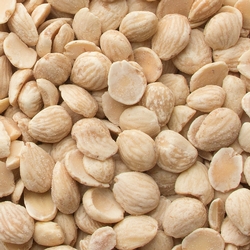


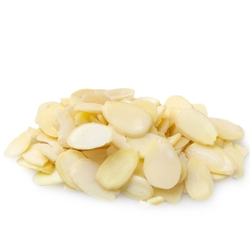

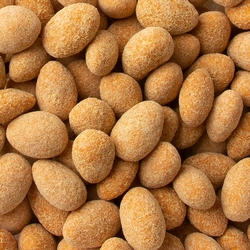


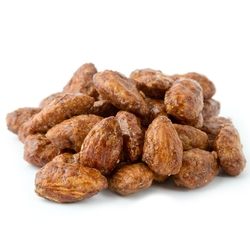
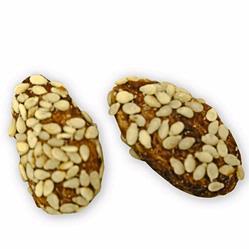

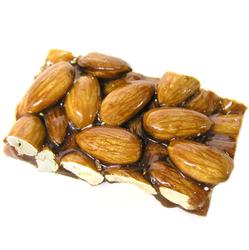
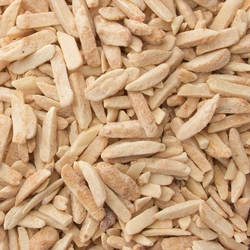
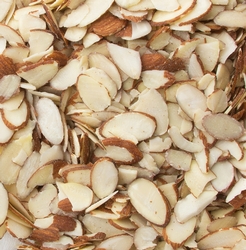
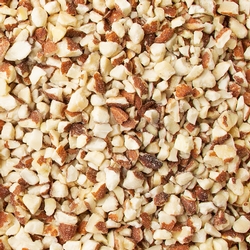
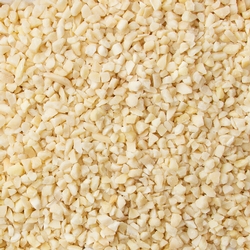
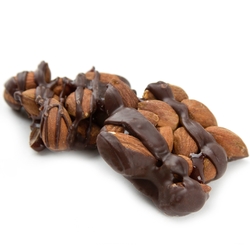
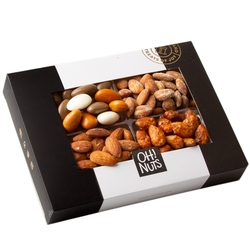
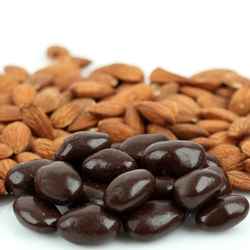

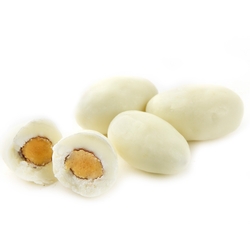
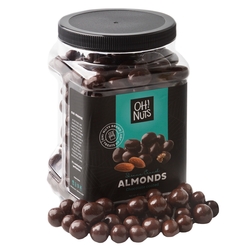
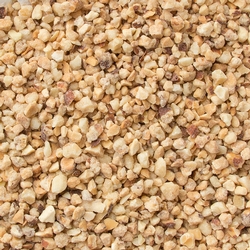
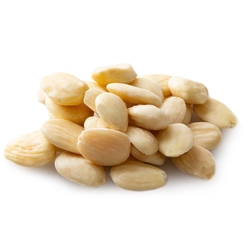
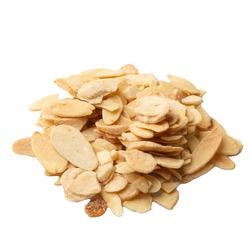
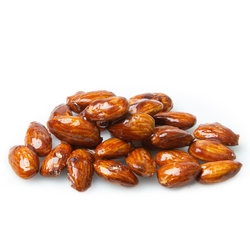
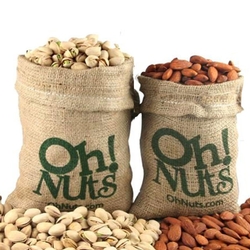

 or
or 
